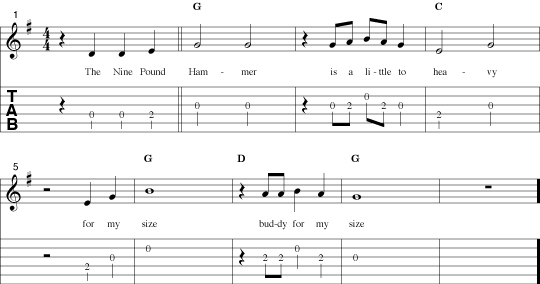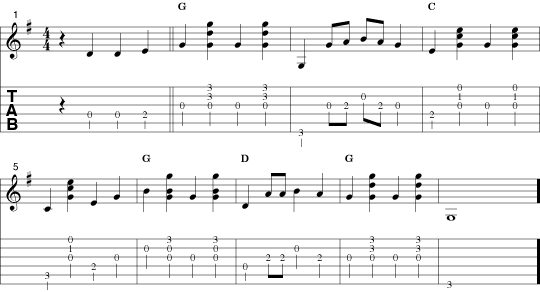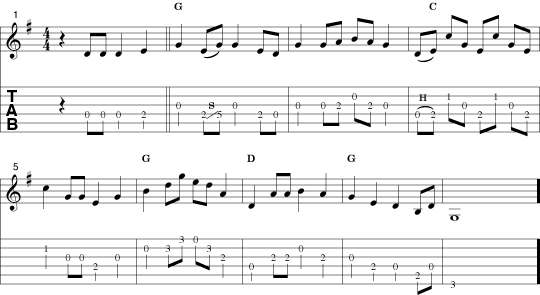|
"Nine Pound Hammer" Arrangement Lesson:
If you don't have much experience coming up with your own arrangements to songs or tunes the homework problem on page 73 of Flatpicking the Blues
may seem like a very challanging task. Your first question may be, "I
don't know where to start!" The answer to that is easy: "You always
start with the melody." Strip the song or tune down to the most basic
melody. Since it is easier to find the melody to vocal numbers (because
you have the vocal line as a reference) we will start with a vocal song
and since your homework assignment was to work up a guitar arrangement
to "Nine Pound Hammer", that is the song we will work with here in this
lesson.
To find the melody, simply get out your guitar, sing each note
of the vocal line, and find the pitch of each note on your guitar as you
sing it. If you don't have experience with this, it may take some
hunting and pecking. Be patient and work through it. Sing the song
slowly, pausing on each word until you find that note on your guitar.
This is good ear training!
The melody to "Nine Pound Hammer" can vary a little depending
on who is singing it. I have transcribed a version of the simple melody
below, included are just the pick-up notes and the first 8 measures. The
first step in learning how to arrange a solo for a song is to play the
simple melody until you get it in your head and under your fingers and
can play it "in your sleep." Play it over, and over, and over. When I
interviewed Richard Bennett for Flatpicking Guitar Magazine he
said that when he teaches students a solo to a new song, he first makes
them play the simply melody until they get, what he called, "melody
burnout." If you want to begin to learn how to arrange solos and
improvise, start each new song or tune you are working on with the
"melody burnout" phase.

Once you have played this melody over and over and over and over, the
next stage in creating a guitar solo is to fill in the silent spaces.
This melody is pretty sparse, so you have some nice spaces to work with.
However, don't jump right in with your hottest licks and fastest runs
right of the bat. Ease into it. The first step is to fill in with some
rhythm strums and/or simple bass runs a-la Mother Maybelle Carter style.
Below I have provided a simple arrangement in this style:

That sounds
OK doesn't it!? That solo probably won't turn heads at the jam session,
but it will get you through. Playing something simple at first allows
you the opportunity to take a solo, helps you get over nervousness, and
helps you get warmed up. Do you see how I stayed exactly with the
melody? I played every melody note and left them exactly where they
were. I simply filled in some bass notes or rhythm strums around the
melody. That is always a good first step.
Next we will take that same melody and fill in some single-note
phrases, or licks. I don't consider this "lick playing" because I'm
leaving the melody pretty much intact. I'm simply filling single-note
runs in around the melody notes. This is not a real fancy solo, but you
can hear how it sounds a little "cooler" than the Carter style solo.
I've added some embellishments, like a slide (measure 2), a hammer-on
(measure 4), some crosspicking (measures 4 & 5), and a short
eighth-note lick (measure 6). Check it out.
Nine Pound Hammer: Simple Single-note Flatpicking Solo 
OK, so now
we have moved from simple melody, to Carter-style arrangement, to
single-note flatpicking arrangement. But this site is about Flatpicking the Blues
and so we now need to add blues influence. I'm going to do this by
adding notes from both the G blues scale and the E blues scale as shown
in Flatpicking the Blues and on the Blues Scale pages of this
web site. Below is the pick-up measure and first eight bars of the song
with a bit of a blues influence added in:
Nine Pound Hammer: Simple Blues Style Solo
|